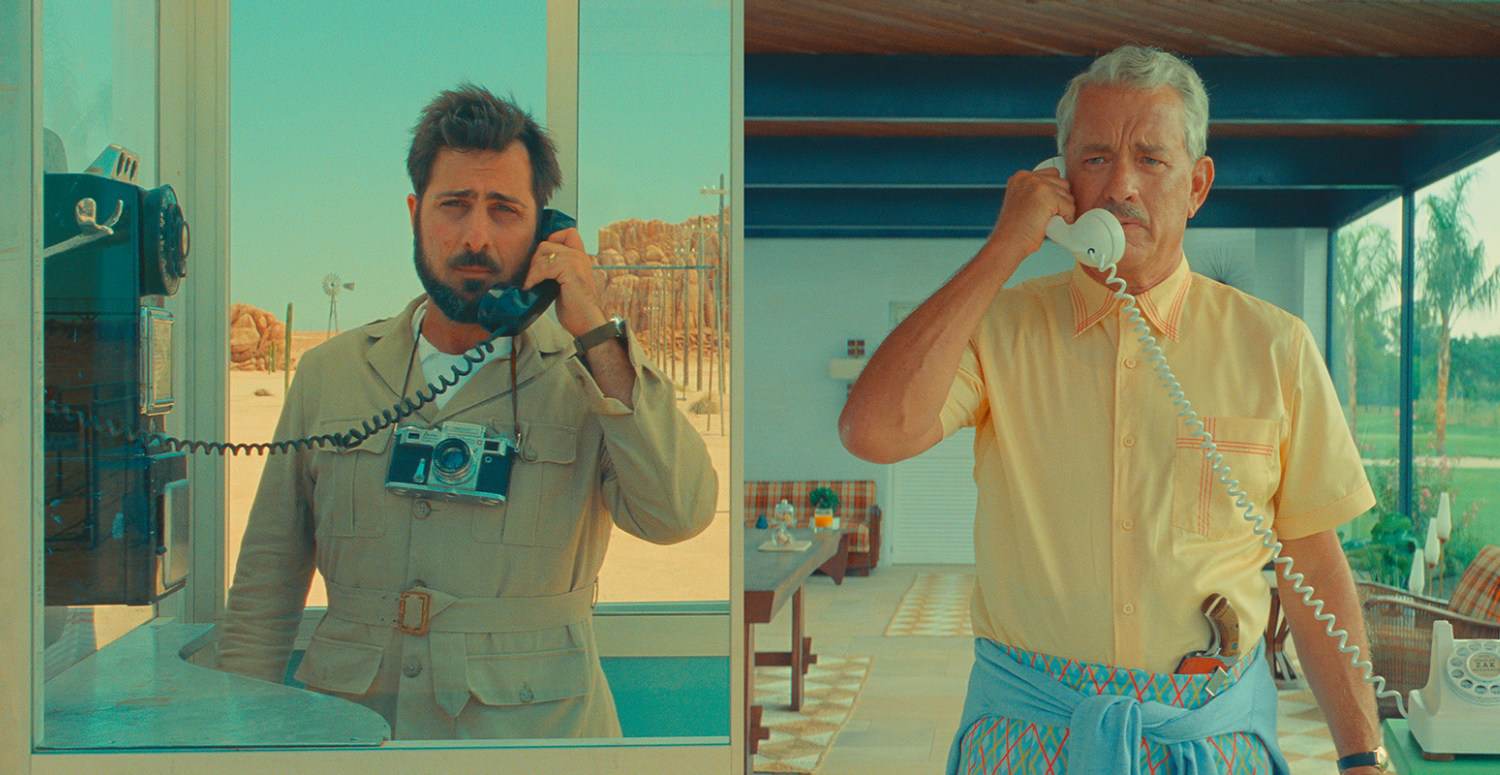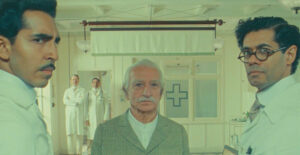Asteroid City
2023

FR EN
Wes Anderson est probablement l’un des réalisateurs contemporains dont le style visuel est le plus caractéristique avec ses plans symétriques, ses décors élaborés et ses palettes de couleurs vives dont « The Grand Budapest Hotel », « Moonrise Kingdom » ou encore « La Famille Tenebaum » sont les plus grandes vitrines. Il est aussi connu pour réunir un casting absolument démentiel où même des grands noms peuvent être cantonnés à la figuration comme dans son précédent film « The French Dispatch », hommage au cinéma français. « Asteroid City » reprend ces différents éléments avec un casting beaucoup trop long pour être cité ici Wes Anderson poursuit donc son œuvre et dans la mesure où ses films sont si particuliers, plutôt inclassables, voilà pourquoi il est dit que Wes Anderson fait une fois de plus du Wes Anderson. D’où ce commentaire récurrent et paradoxal : il se répète et s’enferme dans ses obsessions formalistes, c’est un réalisateur de forme plus que de fond. Il apparaît alors intrigant de s’attacher à percer ce fond, celui d’une œuvre où l’on ne voit pas très bien où elle pourrait nous mener. Serait-ce une chronique post-confinement ? Un commentaire sociétal ? Un pamphlet sur l’incompréhension mutuelle (potentiellement lui-même incompris) ?
Le réalisateur texan, francophile et parisien depuis plusieurs années nous emmène cette fois-ci dans un désert fictif fait de maquettes de très grandes tailles créées par son fidèle chef décorateur Adam Stockausen dans un champ de pastèque près de Madrid. Quelques bungalows épars y côtoient une station-essence, un diner, d’innombrables cactus et le clou du spectacle, un cratère de météorite, sous des couleurs pastel saturées. Si le design et les couleurs d’Asteroid City font si faux, c’est que la ville elle-même se veut fictive. C’est en fait la scène d’une pièce de théâtre dans laquelle nous sommes projetés par une émission de télévision.
Le film s’ouvre ainsi sur un dramaturge entamant l’écriture de sa nouvelle pièce avec un narrateur et présentateur TV donnant vie au récit qui s’incarne ensuite à l’écran. C’est donc un double récit : celui d’une petite ville perdue dans un désert américain en 1955 où plusieurs personnages éclectiques se croisent à l’occasion d’une convention de jeunes cadets de l’espace et abordent les grandes questions de leur vie au gré des tests atomiques effectués au loin ; et un théâtre new-yorkais où se joue sur scène cette même histoire au gré du manque d’inspiration de son dramaturge. « Asteroid City » est ainsi à la fois la ville au cœur du récit, le titre de la pièce de théâtre en question, et celui du film que l’on regarde nous-mêmes. C’est donc une mise en abyme brouillant la frontière entre réalité et fiction départagée par ses changements de formats et de colorimétrie : la pièce de théâtre est retranscrite en format académique (1 :37) en noir et blanc tandis que le récit lui-même, cette intrigue désertique, est quant à elle filmée en couleurs en CinemaScope (2 :39).
Comme toujours chez Wes Anderson, la direction artistique est perfectionniste avec des plans très riches. Il fait preuve d’une impressionnante précision technique dans la composition de la perspective forcée des paysages, des split-screen symétriques s’opposant aux champ-contre-champs asymétriques, ou encore des arrière-plans dénotant avec le dialogue filmé en premier plan. Son récit reprend le même humour décalé plein de références auquel il nous a habitués. Une splendeur visuelle et un monde parfaitement agencé, voire trop bien au point de le rendre fictif, mais qui provoquent moins d’émotions cette fois.
Alors où ce récit (et par extension, cette critique) nous emmène-t-il ? Tout comme dans « The French Dispatch », Wes Anderson ouvre et ferme son film par une mise en abyme (une rédaction de journal puis une pièce de théâtre) avec une histoire de deuil structurant le récit. Celle-ci peut mettre en lumière nos pertes de repères, comme il le fait dès le début du film avec l’absence de son lors des logos de studios. En brouillant ainsi nos repères, il ne peut y avoir une unique clé de lecture. « Asteroid City » peut ainsi s’apparenter à un questionnement métaphysique sur le sens des choses et de nos vies, à un fantasme de confinement avec les scènes de séduction pudique entre bungalows interposés, ou encore à une démonstration du pouvoir de l’artificialité.
Il ne fait plus un film humaniste sur des personnages s’exprimant à travers des œuvres artificielles, il crée cette fois l’œuvre artificielle elle-même et nous laisse la déconstruire et y trouver des éléments humanistes. Le pastiche est en effet si explicite, avec des terrains à vendre qui ne sont pas de vrais terrains dans un récit qui n’existe pas vraiment, que la ville devient essentiellement un décor d’essai atomique où Anderson y teste ses armes. La supercherie est alors le propos même du film, c’est une œuvre de renversement. Les formats et les couleurs sont inversés, le 1 :37 (propre aux émissions TV des années 1950) n’encadre non pas la production que l’on découvre dans le désert mais plutôt les coulisses de la pièce de théâtre, et le 2 :39 n’encadre quant à lui pas la ‘réalité’ théâtrale plus vive que l’histoire errante des protagonistes, mais reste sur ce cadre totalement irréel. De même le récit avance constamment à contretemps avec un premier enjeu de deuil en tupperware résolu dès l’incipit, un conflit familial qui disparaît à l’arrivée des personnages, un alien dont la visite n’a aucune conséquence planétaire, un secret d’Etat qui s’estompe comme un mauvais scandale, ou encore un chèque gagné pour le meilleur projet scientifique qui ne servira finalement absolument pas son but.
Quoi qu’il en soit, une chose est sûre : « Asteroid City » est une œuvre nous poussant à réfléchir aussi bien sur sa forme que son fond, un film qui nous aura interrogés bien après son générique de fin volontairement interminable …
Wes Anderson is probably one of the contemporary directors whose visual style is most distinctive, with its symmetrical shots, elaborate sets and vivid color palettes, of which “The Grand Budapest Hotel”, “Moonrise Kingdom” and “The Royal Tenebaums” are prime examples. He is also known for putting together an absolutely insane cast, where even big names can be reduced to extras, as in his previous film “The French Dispatch”, a tribute to French cinema. “Asteroid City” takes up all these elements, with a cast far too long to be listed here. Wes Anderson thus pursues his work, and insofar as his films are so particular, rather unclassifiable, that’s why it’s said that Wes Anderson is once again doing a Wes Anderson movie. Hence this recurring and paradoxical criticism: he’s repeating himself and confining himself to his formalist obsessions; he’s more a director of style than substance. It’s intriguing, then, to try to get to the bottom of a work where it’s hard to see where it might lead. Could it be a post-lockdown chronicle? A societal statement? A plea on mutual misunderstanding (potentially itself misunderstood)?
The Texan director, a Francophile who has been living in Paris for several years, takes us this time to a fictitious desert made up of very large-scale miniatures created by his long-time production designer Adam Stockausen in a watermelon field near Madrid. A few scattered bungalows hang alongside a gas station, a diner, countless cacti and the highlight of the show, a meteorite crater, under saturated pastel colors. If Asteroid City’s design and colors look so fake, it’s because the city itself is intended to be fictional. It is, in fact, the stage of a play into which we are projected by a television program.
The film opens with a playwright starting to write his new play, with a narrator and TV presenter bringing the story to life, which is then brought to life on screen. It’s a double story: that of a small town lost in an American desert in 1955, where several eclectic characters meet at a convention of young space cadets and discuss the big questions of their lives while atomic tests are being conducted in the distance; and a New York theater where the same story is played out on stage to suit the playwright’s lack of inspiration. “Asteroid City” is therefore both the city at the heart of the story, the title of the play itself, and that of the film we ourselves are watching. It’s a mise en abyme that blurs the line between reality and fiction, and is delineated by changes in aspect ratio and colorimetry: the play is filmed in Academy ratio (1:37) in black and white, while the story itself, the desertic plot, is filmed in color CinemaScope (2:39).
As always with Wes Anderson, the art direction is perfectionist, with richly layered shots. He demonstrates impressive technical precision in the composition of forced perspective landscapes, symmetrical split-screens in contrast to asymmetrical shot/reverse shots, and backgrounds that contrast with the dialogue filmed in the foreground. The story is told with the same quirky, referential humor he’s become known for. A visual wonder and a world that’s perfectly crafted, even too well-crafted to the point of fictitiousness, though less emotionally engaging this time around.
So where does this story (and by extension, this review) take us? As in “The French Dispatch”, Wes Anderson opens and closes his film with a mise en abyme (a newspaper editorial and then a theater play), with a story of grief structuring the narrative. This can highlight our loss of bearings, as he already illustrates at the start of the film with the absence of sound during the studio logos. By blurring our bearings in this way, there can be no single key to interpreting the film. “Asteroid City” can thus be seen as a metaphysical questioning of the meaning of things and of our lives, as a fantasy of lockdown with the scenes of bashful seduction across bungalows, or as a display of the power of artificiality.
He is no longer making a humanistic film about characters expressing themselves through artificial works, this time he creates the artificial work itself, leaving us to deconstruct it and find humanistic elements within it. Indeed, the pastiche is so explicit, with lots for sale that aren’t real lots in a story that doesn’t really exist, that the town essentially becomes a nuke town where Anderson tests his own guns. Deceit, then, is the very purpose of the film, a work of reversal. The aspect ratios and colors are reversed, with the 1:37 (typical of 1950s TV programs) not framing the production we see in the desert, but rather the backstage action of the play, and the 2:39 not framing the theatrical ‘reality’ more alive than the wandering story of the protagonists, but remaining on this totally unreal setting. Likewise, the story constantly works off-beat, with an initial ‘Tupperware’ mourning issue solved in the very beginning, a family feud that disappears as soon as the characters arrive, an alien whose visit has no planetary repercussions, a state secret that fades away like a cheap scandal, or a winning check for the best scientific project that ultimately doesn’t serve its purpose at all.
Be that as it may, one thing is sure: “Asteroid City” is a thought-provoking work in both style and substance, a film that will have us wondering long after its deliberately endless closing credits…

